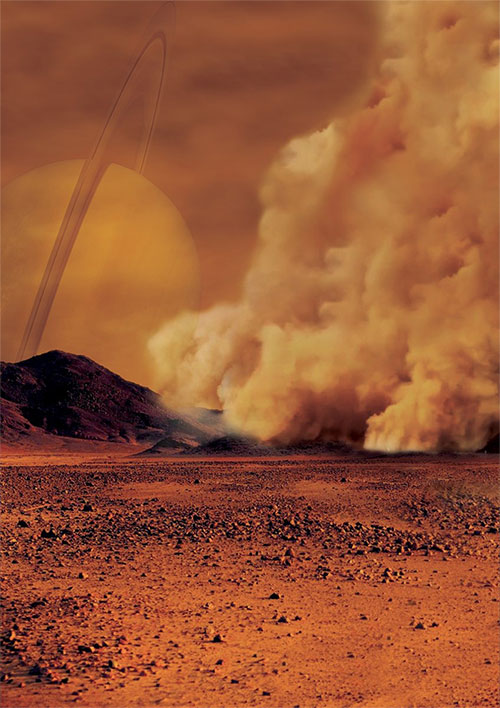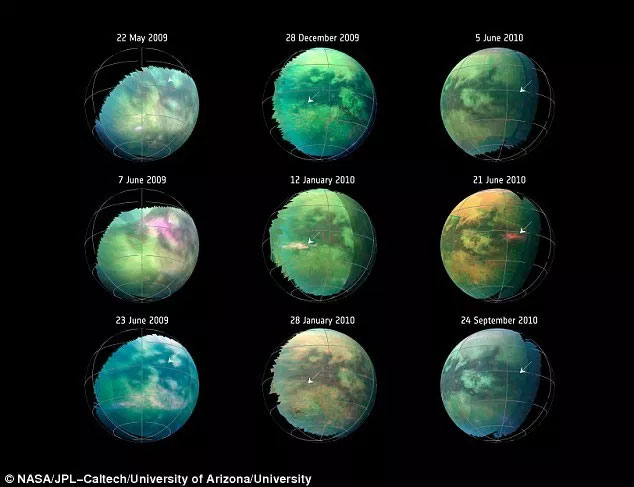Super dust storms show signs of life on Saturn moon
Complex organic molecules hidden in giant dust storms increase the hope of finding life on the moon that has been dubbed "alien planet" by NASA .
The work has just been published in the scientific journal Nature Geoscience, based on NASA's latest data on Saturn collected.
This data has strengthened the hope of finding extraterrestrial life on this celestial body.

Huge dust storm emerged on Titan moon - (graphic of the research team).
Specifically, scientists have just analyzed data on giant dust storms , covering most of the planet during the years 2004-2017 and discovering them with precious signs of extraterrestrial life. : Organic and complex molecules.
Particularly, the appearance of dust storms is also a factor showing that this moon is really like the earth to strange, as previous studies have analyzed. This is the third of the hundreds of celestial bodies in the Solar System to detect dust storms. The other two bodies are Earth and Mars, one has life and one has evidence of ancient life.

Close up of 7 super typhoons spread more than half of Titan's surface - (NASA graphic image).
This super dust storm consists of particulate matter lifted from the large sand dunes around the equator of Titan, by a powerful methane storm. Complex organic molecules are found by analyzing atmospheric chemistry when dust storms emerge.
Before the dust storm was discovered, Titan had been likened to NASA by an alien planet. Titan has a terrain similar to the earth, a lot of sea, liquid methane lake and there is evidence that many places on its surface can be covered by organic molecules. This is the second celestial body in the Solar System, after Earth, which has a stable liquid on the surface.
"Titan is a very lively moon, " said astronomer Sebastien Rodriguez (Paris Diderot, France), who heads the multinational research group.
According to a previous US study, published in the journal Astrobiology, the reason that carbon-rich organic molecules thought to exist on the surface of Titan has not yet developed into life, because this object is too cold. (about -179 degrees C). However, scientists are looking for life to craters and deep craters, which are warmer places.
In the middle of last month, NASA also published one of the most up-close images of the Titan moon that the Cassini spacecraft captured on the suicide "suicide" path.

Titanium surface with liquid methane lakes - (photo: NASA).
After 20 years with repeated renewals, Cassini plunged into Saturn's atmosphere to be completely destroyed last year. However it took some time for its final images to reach the earth and be processed before the public was released.
- Add convincing evidence of life on Saturn moon
- 50 images of Saturn's Enceladus moon - where life can exist (Part 1)
- Find the river on Saturn's moon
- 50 images of Saturn's Enceladus moon - where life may exist (Part 2)
- Life may exist on Saturn's moon
- Add a Saturn moon that owns the ocean and ... oxygen
- Saturn has a newborn moon
- Hot water lake on Saturn is detected
- Hope to find extraterrestrial life on Saturn's Titan moon
- Super typhoon on Jupiter is narrowing
- Detecting signs of water on the moon
- Cassini flies close to the moon of Saturn
 Van Allen's belt and evidence that the Apollo 11 mission to the Moon was myth
Van Allen's belt and evidence that the Apollo 11 mission to the Moon was myth The levels of civilization in the universe (Kardashev scale)
The levels of civilization in the universe (Kardashev scale) Today Mars, the sun and the Earth are aligned
Today Mars, the sun and the Earth are aligned The Amazon owner announced a secret plan to build a space base for thousands of people
The Amazon owner announced a secret plan to build a space base for thousands of people